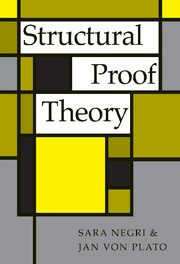Book contents
- Frontmatter
- Contents
- PREFACE
- INTRODUCTION
- 1 FROM NATURAL DEDUCTION TO SEQUENT CALCULUS
- 2 SEQUENT CALCULUS FOR INTUITIONISTIC LOGIC
- 3 SEQUENT CALCULUS FOR INTUITIONISTIC LOGIC
- 4 THE QUANTIFIERS
- 5 VARIANTS OF SEQUENT CALCULI
- 6 STRUCTURAL PROOF ANALYSIS OF AXIOMATIC THEORIES
- 7 INTERMEDIATE LOGICAL SYSTEMS
- 8 BACK TO NATURAL DEDUCTION
- CONCLUSION: DIVERSITY AND UNITY IN STRUCTURAL PROOF THEORY
- APPENDIX A SIMPLE TYPE THEORY AND CATEGORIAL GRAMMAR
- APPENDIX B PROOF THEORY AND CONSTRUCTIVE TYPE THEORY
- APPENDIX C PESCA – A PROOF EDITOR FOR SEQUENT CALCULUS (by Aarne Ranta)
- BIBLIOGRAPHY
- AUTHOR INDEX
- SUBJECT INDEX
- INDEX OF LOGICAL SYSTEMS
5 - VARIANTS OF SEQUENT CALCULI
Published online by Cambridge University Press: 25 February 2010
- Frontmatter
- Contents
- PREFACE
- INTRODUCTION
- 1 FROM NATURAL DEDUCTION TO SEQUENT CALCULUS
- 2 SEQUENT CALCULUS FOR INTUITIONISTIC LOGIC
- 3 SEQUENT CALCULUS FOR INTUITIONISTIC LOGIC
- 4 THE QUANTIFIERS
- 5 VARIANTS OF SEQUENT CALCULI
- 6 STRUCTURAL PROOF ANALYSIS OF AXIOMATIC THEORIES
- 7 INTERMEDIATE LOGICAL SYSTEMS
- 8 BACK TO NATURAL DEDUCTION
- CONCLUSION: DIVERSITY AND UNITY IN STRUCTURAL PROOF THEORY
- APPENDIX A SIMPLE TYPE THEORY AND CATEGORIAL GRAMMAR
- APPENDIX B PROOF THEORY AND CONSTRUCTIVE TYPE THEORY
- APPENDIX C PESCA – A PROOF EDITOR FOR SEQUENT CALCULUS (by Aarne Ranta)
- BIBLIOGRAPHY
- AUTHOR INDEX
- SUBJECT INDEX
- INDEX OF LOGICAL SYSTEMS
Summary
In this chapter we present different formulations of sequent calculi. In Sections 5.1 and 5.2 we give calculi with independent contexts in two versions, one with explicit rules of weakening and contraction, the other with these rules built into the logical rules similarly to natural deduction. The proofs of cut elimination for these calculi are quite different from each other and from the earlier proofs for the G3 calculi. For calculi of the second type in particular, with implicit weakening and contraction, cut elimination will be limited to cut formulas that are principal somewhere in the derivation of the right premiss of cut. All other cut formulas are shown to be subformulas of the conclusion already.
The structure of derivations in calculi with independent contexts is closely connected to the structure of derivations in natural deduction. The correspondence will be studied in Chapter 8.
In Section 5.3 we present an intuitionistic multisuccedent calculus and its basic properties. The calculus has a right disjunction rule that is invertible, which is very useful in proof search. The calculus is also used in the study of extensions of logical sequent calculi with mathematical axioms in Chapter 6.
We also present a single succedent calculus for classical propositional logic. Its main advantage compared with the multisuccedent calculus G3cp is that it has an operational interpretation and a straightforward translation to natural deduction. The calculus is obtained from the intuitionistic calculus G3ip by the addition of a sequent calculus rule corresponding to the law of excluded middle.
- Type
- Chapter
- Information
- Structural Proof Theory , pp. 87 - 125Publisher: Cambridge University PressPrint publication year: 2001



